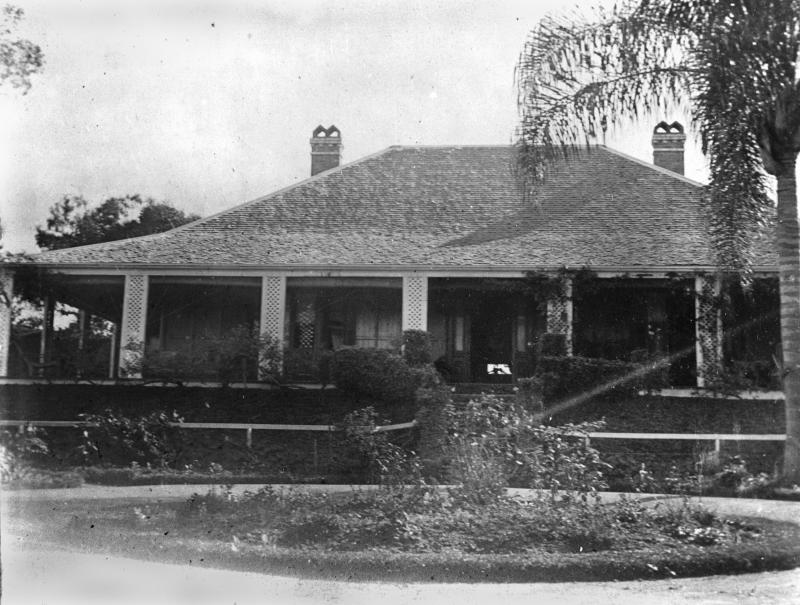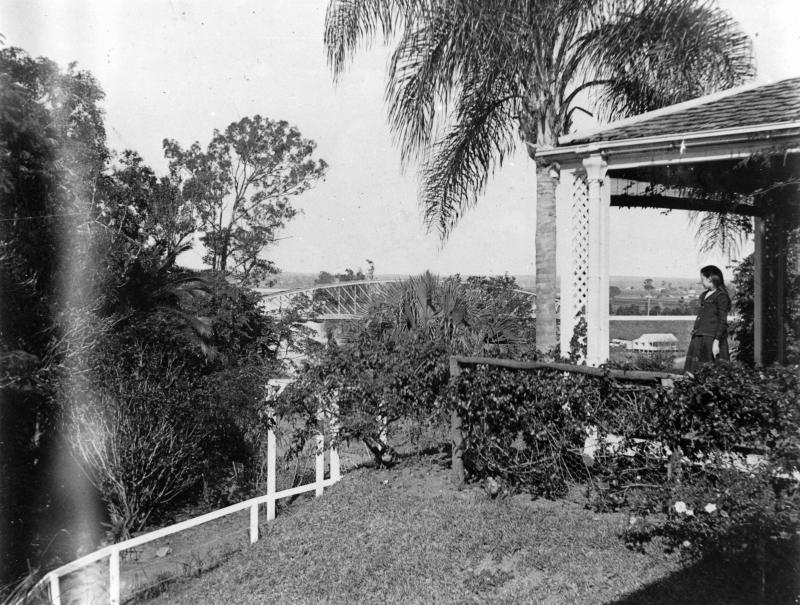Addresses
Type of place
House
Period
Victorian 1860-1890
Style
Queenslander
Addresses
Type of place
House
Period
Victorian 1860-1890
Style
Queenslander
This substantial residence was built circa 1886-1888 for Justin Fox Greenlaw Foxton (1849-1916), notable Queensland politician, barrister and soldier. It provides evidence of the development of Indooroopilly as an elite, riverside, residential suburb of Brisbane in the late nineteenth century.
Lot plan
L6_RP803072; L5_RP803072
Key dates
Local Heritage Place Since —
Date of Citation —
Construction
Roof: Corrugated iron;Walls: Timber
People/associations
Justin Fox Greenlaw Foxton (Occupant)Criterion for listing
(A) Historical; (H) Historical associationInteractive mapping
Lot plan
L6_RP803072; L5_RP803072
Key dates
Local Heritage Place Since —
Date of Citation —
Construction
Roof: Corrugated iron;Walls: Timber
People/associations
Justin Fox Greenlaw Foxton (Occupant)Criterion for listing
(A) Historical; (H) Historical associationInteractive mapping
History
In 1886, Justin Fox Greenlaw Foxton purchased 6 acres of land overlooking the Brisbane River at Indooroopilly. Post Office Directory (PODs) entries indicate that he was residing on the property in The Priory by 1888.
Foxton was born in Melbourne on 24 September 1849, the son of an accountant and former naval officer, Captain John Greenlaw Foxton and Isabel, nee Potts. After a private school education at Melbourne Church of England Grammar School and a period of jackerooing in Queensland, he was articled to J. M. Thompson of Ipswich. Foxton was admitted to the Bar in 1871. After a short period of practice in Stanthorpe, he established himself in partnership with Thompson in Brisbane in 1878. According to an historical article about Indooroopilly published in the Brisbane Courier in 1931, Foxton occupied the house of E. M. Long also on the riverbank of Indooroopilly prior to building The Priory.
From the 1880s until his defeat in 1910, Foxton enjoyed a successful political career in both State and Federal politics. He was MLA for Carnarvon from 1883 to 1904 and served as secretary for public lands from 1896 to 1898 and again in 1903 and Home Secretary under Dickson and Philip from 1898 to 1903. From 1906 to 1910, Foxton was the Federal member for Brisbane.
Foxton was involved in several significant pieces of Queensland legislation, such as the Land Act of 1897. He initiated the Factories and Shops Act of 1900 which regulated workplace practices and child labour and the 1901 Aboriginals Protection and Restriction of the Sale of Opium Act which introduced policed missions for Aboriginal people and stopped some female exploitation. Foxton was a supporter of State rights and a fervent anti-socialist. He had an association of over 30 years with the militia, ending his military career as commandant of the Queensland Brigade of the Field Artillery in 1912.
Foxton’s contribution to the social fabric of Queensland included serving as the grand registrar of the United Grand Lodge of Queensland, helping to found the Historical Society of Queensland and acting as president of the Queensland Cricket Association.
The Priory was Foxton’s home until around 1912 when he moved to Bulimba. He died at South Brisbane on 23 June 1916 and was buried at Toowong Cemetery. His wife, two sons and a daughter survived him.
Of note is the large fig tree located near the eastern boundary of the property. This fig tree, dated between 120-140 years old, may well have been planted as part of the original garden at the time, or shortly after, the house was constructed.
A 1995 article in the Courier Mail claims that The Priory once had a shingled roof and that the property includes a ‘timber coach house’ and ‘former stables’. Extensions to the house include an additional wing. The article also describes features of the house such as ‘three cedar arches lining the wide hallway....elaborate pressed metal ceilings, marble fireplaces, hoop pine floorboards, cedar architraves and bay windows with French doors’. An internal inspection would be necessary to determine which features of the house are original.
Description
This building does not offer its front elevation to the street as it was built to face the river. What is visible from the street is a steep pitched metal roof, timber walls and a pair of nineteenth century style chimneys. The front elevation which features broad verandas edged with paired veranda posts with lattice infill graces the riverside view of the house.
Statement of significance
Relevant assessment criteria
This is a place of local heritage significance and meets one or more of the local heritage criteria under the Heritage planning scheme policy of the Brisbane City Plan 2014. It is significant because:
Supporting images

Photographer unknown,
'View from the formal front gardens of The Priory, Indooroopilly, ca. 1904',
John Oxley Library, State Library of Queensland

Photographer unknown,
'Young girl looking towards the Indooroopilly rail bridge and the Brisbane River, from the verandah of The Priory, ca. 1904',
John Oxley Library, State Library of Queensland
References
-
Brisbane Courier, 15 Aug 1931
-
Courier Mail, 9 Sept 1995
-
Nairn, Bede and Geoffrey Serle, (gen. eds.). Australian Dictionary of Biography. Vol.8 1891-1939. Melbourne: MUP, 1981
-
Queensland Certificates of Title
-
Queensland Post Office Directories
Citation prepared by — Brisbane City Council (page revised September 2020)